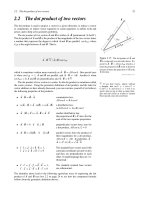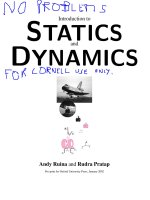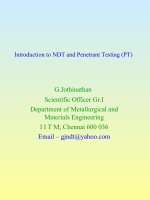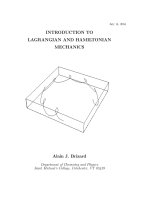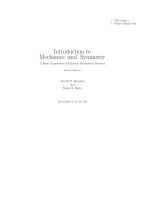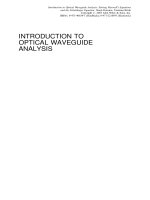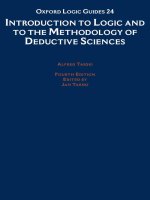Richard courant, fritz john introduction to calculus and analysis, vol 1 interscience publishers (1998)
Bạn đang xem bản rút gọn của tài liệu. Xem và tải ngay bản đầy đủ của tài liệu tại đây (21.16 MB, 682 trang )
INTRODUCTION TO CALCULUS AND ANALYSIS
Volume
One
www.pdfgrip.com
Other Books by the Same Authors
Richard Courant
1937; Vol. II, first edition, 1936
Differential and Integral Calculus, Interscience Publishers,
Vol. I, second edition,
1950
Dirichlet's Principles, Conformal Mapping and Minimal Surfaces,
Interscience Publishers,
I, 1953; Vol. II, 1962; Vol. III, in press.
Methods of Mathematical Physics (and D. Hilbert), Interscience
Publishers, Vol.
Supersonic Flow and Shock Waves (and K. 0. Friedrichs),
Interscience Publishers,
1948
Fritz John
1964
Partial Differential Equations (and L. Bers and M. Schechter),
Interscience Publishers,
Equations, Interscience Publishers, 1955
Plane Waves and Spherical Means Applied to Partial Differential
www.pdfgrip.com
Introduction to
CALCULUS AND ANALYSIS
Volume One
Richard Courant and Fritz John
Courant I nstitute of Mathematical Sciences
New York University
lnterscience Publishers
A Division of John
New York
·
Wiley
London
and Sons, Inc.
· Sydney
www.pdfgrip.com
Copyright © 1965 by Richard Courant
All Rights Reserved. This book or any part thereof must not
be reproduced in any form without the written permission of
the publisher.
Library of Congress Catalog Card Number: 65-/6403
Printed in the United States of America
www.pdfgrip.com
Preface
During the latter part of the seventeenth century the new mathe
matical analysis emerged as the dominating force in mathematics.
It is characterized by the amazingly successful operation with infinite
processes or limits. Two of these processes, differentiation and inte
gration, became the core of the systematic Differential and Integral
Calculus, often simply called "Calculus," basic for all of analysis.
The importance of the new discoveries and methods was immediately
felt and caused profound intellectual excitement. Yet, to gain mastery
of the powerful art appeared at first a formidable task, for the avail
able publications were scanty, unsystematic, and often lacking in
clarity. Thus, it was fortunate indeed for mathematics and science
in general that leaders in the new movement soon recognized the
vital need for writing textbooks aimed at making the subj ect ac
cessible to a public much larger than the very small intellectual elite of
the early days.
One of the greatest mathematicians of modern times,
Leonard Euler, established in introductory books a firm tradition and
these books of the eighteenth century have remained sources of inspira
tion until today, even though much progress has been made in the
clarification and simplification of the material.
After Euler, one author after the other adhered to the separation of
differential calculus from integral calculus, thereby obscuring a key
point, the reciprocity between differentiation and integration.
Only in
R . Courant's German Vorlesungen iiber
Differential und Integralrechnung, appeared in the Springer-Verlag
1 927
when the first edition of
was this separation eliminated and the calculus presented as a unified
subj ect.
From that German book and its subsequent editions the present
work originated. With the cooperation of James and Virginia McShaue
a greatly expanded and modified English edition of the "Calculus" w�s
prepared and published by Blackie and Sons in Glasgow since
v
1 934,
and
www.pdfgrip.com
vi Preface
distributed in the United States in numerous reprintings by Inter
science-Wiley.
During the years it became apparent that the need of college and uni
versity instruction in the United States made a rewriting of this work
desirable. Yet, it seemed unwise to tamper with the original versions
which have remained and still are viable.
Instead of trying to remodel the existing work it seemed preferable to
supplement it by an essentially new book in many ways related to the
European originals but more specifically directed at the needs of the
present and future students in the United States. Such a plan became
feasible when Fritz John, who had already greatly helped in the prepara
tion of the first English edition , agreed to write the new book together
with R. Courant.
While it differs markedly in form and content from the original, it is
animated by the same i ntention : To lead the student directly to the
heart of the subject and to prepare him for active application of his
knowledge. It avoids the dogmatic style which conceals the motivation
and the roots of the calculus in intuitive reality. To exhibit the interac
tion between mathematical analysis and its various applications and to
emphasize the role of intuition remains an i mportant aim of this new
book. Somewhat strengthened precision does not, as we hope, inter
fere with this aim.
Mathematics presented as a closed, linearly ordered, system of truths
without reference to origin and purpose has its charm and satisfies a
philosophical need. But the attitude of introverted science is unsuitable
for students who seek intellectual independence rather than indoctrina
tion ; disregard for applications and intuition leads to isolation and
atrophy of mathematics. It seems extremely i mportant that students
and instructors should be protected from smug purism.
The book is addressed to students on various levels, to mathema
ticians, scientists, engineers . It does not pretend to make the subj ect
easy by glossing over difficulties, but rather tries to help the genuinely
interested reader by throwing light on the interconnections and purposes
of the whole.
Instead of obstructing the access to the wealth of facts by lengthy
discussions of a fundamental nature we have sometimes postponed such
discussions to appendices in the various chapters.
Numerous examples and problems are given at the end of various
chapters. Some are challenging, some are even difficult ; most of them
supplement the material in the text. In an additional pamphlet more
www.pdfgrip.com
Preface vii
problems and exercises of a routine character will be collected, and
moreover, answers or hints for the solutions will be given.
Many colleagues and friends have been helpful. Albert A . Blank
not only greatly contributed incisive and constructive criticism, but he
also played a maj or role in ordering, augmenting, and sifting of the
problems and exercises, and moreover he assumed the main responsi
bility for the pamphlet. Alan Solomon helped most unselfishly and
effectively in all phases of the preparation of the book. Thanks is also
due to Charlotte John, Anneli Lax, R. Richtmyer, and other friends,
including James and Virginia McShane.
The fi rst volume i s concerned primarily with functions of a single
variable, whereas the second volume will discuss the more ramified
theories of calculus for functions of several variables.
A final remark should be addressed to the student reader. It might
prove frustrating to attempt mastery of the subj ect by studying such a
book page by page following an even path. Only by selecting shortcuts
first and returning time and again to the same q uestions and d ifficulties
can one gradually attain a better understanding from a more elevated
point.
An attempt was made to assist users of the book by marking with an
asterisk some passages which might impede the reader at his fi rst at
tempt. Also some of the more difficult problems are marked by an
asterisk.
We hope that the work in the present new form will be useful to the
young generation of scientists. We are aware of many imperfections
and we sincerely invite critical comment which might be helpful for later
improvements.
Richard Courant
Fritz John
J une 1965
www.pdfgrip.com
www.pdfgrip.com
Contents
Chapter
1
1
Introduction
1.1
1.2
1.3
1.4
1.5
The Continuum of Numbers
a. The System of Natural Numbers and Its
Extension. Counting and Measuring, 1
b. Real Numbers and Nested Intervals, 7
c. Decimal Fractions. Bases Other Than
Ten, 9 d. Definition of Neighborhood, 1 2
e . Inequalities, 1 2
1
The Concept of Function
b . Definition o f the
a. Mapping-Graph, 1 8
Concept of Functions of a Continuous
Variable. Domain and Range of a Function, 2 1
c . Graphical Representation. Monotonic
Functions, 24 d. Continuity, 31 e . The
Intermediate Value Theorem. Inverse
Functions, 44
17
The Elementary Functions
b. Algebraic
a. Rational Functions, 47
Functions, 49 c. Trigonometric Functions, 49
d. The Exponential Function and the
Logarithm, 5 1 e . Compound Functions,
Symbolic Products, Inverse Functions, 52
Sequences
47
55
Mathematical Induction
57
ix
www.pdfgrip.com
x
Contents
1.6
The Limit of a Sequence
I
8. Un
=
C. Un
=
-,
n
61
_!!___! ,
b.
azm
= -;
I
m
d. an
63
I
Uzm-1
=
zyp, 64
60
62
Zm'
e. an = a", 65
f. Geometrical Illustration of the Limits of
h.
a"
1.7
1.8
and
Un
=
n+
zyp, 65
� 69
=
g. The Geometric Series, 67
i.
an
=
�
-
y;;, 69
Further Discussion of the Concept of Limit
Definition of Convergence and Divergence, 70
b. Rational Operations with Limits, 71
c. Intrinsic Convergence Tests. Monotone
Sequences, 73 d. Infinite Series and the
Summation Symbol, 75 e. The Number e, 77
f. The Number 1r as a Limit, 80
a.
70
The Concept of Limit for Functions of a Continuous Variable
82
Some Remarks about the Elementary
Functions, 86
a.
Supplements
87
S.1
89
Limits and the Number Concept
The Rational Numbers, 89 b. Real
Numbers Determined by Nested Sequences of
Rational Intervals, 90 c. Order, Limits, and
Arithmetic Operations for Real Numbers, 92
d. Completeness of the Number Continuum.
Compactness of Closed Intervals. Convergence
Criteria, 94 e. Least Upper Bound and
Greatest Lower Bound, 97 f. Denumerability
of the Rational Numbers, 98
a.
S.2
Theorems on Continuous Functions
S.3
Polar Coordinates
S.4
Remarks on Complex Numbers
PROBLEMS
99
101
103
106
www.pdfgrip.com
Contents xi
Chapter
2
The Fundamental Ideas of the Integral
and Differential Calculus
119
2.1
The Integral
a. Introduction, 1 20
b. The Integral as an
Area, 1 2 1 c. Analytic Definition of the
Integral. Notations, 1 22
2.2
128
Elementary Examples of Integration
a. Integration of Linear Function, 1 28
b. Integration of x2, 1 30
c. Integration of
x"' for Integers a � - I , 131 d. Integration of
x"' for Rational a Other Than -I, 1 34
e. Integration of sin x and cos x, 1 35
2.3
Fundamental Rules of Integration
a. Additivity, 1 36
b. Integral of a Sum of a
Product with a Constant, 1 37 c. Estimating
Integrals, 1 38, d. The Mean Val ue Theorem
for Integrals, 1 39
2.4
The Integral as a Function of the Upper Limit
(Indefinite Integral)
143
2.5
Logarithm Defined by an Integral
a. Definition of the Logarithm Function, 145
b. The Addition Theorem for Logarithms, 147
145
2.6
Exponential Function and Powers
a. The Logarithm of the Number e, 1 49
b. The Inverse Function of the Logarithm.
The Exponential Function, 1 50
c. The Exponential Function as Limit of
Powers, 1 52 d. Definition of Arbitrary
Powers of Positive Numbers, 1 52
e. Logarithms to Any Base, 1 53
149
2.7
The Integral of an Arbitrary Power of x
154
2.8
The Derivative
a. The Derivative and the Tangent, 1 56
b. The Derivative as a Velocity, 162
155
120
136
www.pdfgrip.com
xii
Contents
c. Examples of Differentiation, 163
d. Some
Fundamental Rules for Differentiation, 165
e. Differentiability and Continuity of Functions,
166
f. Higher Derivatives and Their
Significance, 169 g. Derivative and Difference
Quotient. Leibnitz's Notation, 171 h. The
Mean Value Theorem of Differential Calculus, 173
i. Proof of the Theorem, 175 j. The
Approximation of Functions by Linear
Functions. Definition of Differentials, 179
k. Remarks on Applications to the Natural
Sciences, 183
2.9
The Integral, the Primitive Function, and the
Fundamental Theorems of the Calculus
184
The Derivative of the Integral, 184 b. The
Primitive Function and Its Relation to the
Integral, 186 c. The Use of the Primitive
Function for Evaluation of Definite Integrals, 189
d. Examples, 191
a.
Supplement
The Existence of the Definite Integral
PROBLEMS
192
The Techniques of Calculus
201
Part A Differentiation and Integration of the
Elementary Functions
201
of a Continuous Function
Chapter
3
3.1
196
The Simplest Rules for Differentiation and
Their Applications
Rules for Differentiation, 201
b. Differentiation of the Rational Functions, 204
c. Differentiation of the Trigonometric
Functions, 205
201
a.
3.2
The Derivative of the Inverse Function
General Formula, 206 b. The Inverse of
a.
the nth Power; Lie nth Root, 210
Inverse Trigonometric Functions-
c.
The
206
www.pdfgrip.com
Contents
d. The Corresponding
Multivaluedness, 210
Integral Formulas, 215
3.3
Derivative and
Differentiation of Composite Functions
c.
3.4
e.
Integral of the Exponential Function, 216
a. Definitions, 217
xiii
b. The Chain Rule, 218
217
The Generalized Mean Value Theorem of the
Differential Calculus, 222
Some Applications of the Exponential
Function
a. Definition of the Exponential Function by
223
Means of a Differential Equation, 223
b. Interest Compounded Continuously.
Radioactive Disintegration, 224 c. Cooling
or Heating of a Body by a Surrounding
Medium, 225
d. Variation of the
Atmospheric Pressure with the Height above
the Surface of the Earth, 226 e. Progress of a
Chemical Reaction, 227
3.5
f. Switching an
Electric Circuit on or off, 228
The Hyperbolic Functions
a. Analytical Definition, 228
b. Addition
228
Theorems and Formulas for Differentiation 231
c.
3.6
The Inverse Hyperbolic Functions, 232
d. Further Analogies, 234
Maxima and Minima
a.
Convexity and Concavity of Curves, 236
236
b. Maxima and Minima-Relative Extrema.
3. 7
Stationary Points, 238
The Order of Magnitude of Functions
a. The Concept of Order of Magnitude. The
Simplest Cases, 248
b. The Order of
Magnitude of the Exponential Function and of
the Logarithm, 249 c. General Remarks, 251
d. The Order of Magnitude of a Function in the
Neighborhood of an Arbitrary Point, 252
Function Tending to Zero, 252 f. The "0"
and "o" Notation for Orders of Magnitude, 253
e.
The Order of Magnitude (or Smallness) of a
248
www.pdfgrip.com
xiv Contents
APPENDIX
A.1
The Function y = eiix2, 255 b. The
Function y = eiix, 256 c. The Function
y = tanh 1/x, 257 d. The Function
y = x tanh 1/x, 258 e. The Function
y = x sin 1/x, y(O) = 0, 259
Some Special Functions
255
255
a.
A.2
Remarks on the Differentiability of Functions 259
Part B Techniques of Integration
3.8
3.9
261
Table of Elementary Integrals
263
The Method of Substitution
263
The Substitution Formula. Integral of a
Composite Function, 263 b. A Second
Derivation of the Substitution Formula, 268
c. Examples. Integration Formulas, 270
a.
3.10 Further Examples of the Substitution Method 271
274
3.1 1 Integration by Parts
a. General Formula, 274
b. Further Examples
of Integration by Parts, 276 c. Integral
Formula for (b) + f(a), 278 d. Recursive
Formulas, 278
•e. Wallis's Infinite Product
for 1r, 280
3.12 Integration of Rational Functions
282
b. Integration
a. The Fundamental Types, 283
of the Fundamental Types, 284 c. Partial
Fractions, 286 d. Examples of Resolution
into Partial Fractions. Method of
Undetermined Coefficients, 288
3.13 Integration of Some Other Classes of
Functions
Preliminary Rennarks on the Rational
Representation of the Circle and the
Hyperbola, 290 b. Integration of
R(cos x, sin x), 193 c. Integration of
a.
290
www.pdfgrip.com
Contents xv
R(cosh x, sinh x), 294
R( x, ·v}-=.--:;2), 294
d. Integration of
vg-=-1), 295 f. Integration of
g. Integration of
R( x, �). 295
R( x, v ax2 + 2bx +c), 295 h. Further
R( x,
e.
Integration of
Examples of Reduction to Integrals of Rational
Functions, 296
i. Remarks on the Examples,
297
Part C Further Steps in the Theory of Integral
Calculus
3.14
Integrals of Elementary Functions
a.
298
298
Definition of Functions by Integrals. Elliptic
Integrals and Functions, 298
b. On
Differentiation and Integration, 300
3.15
Extension of the Concept of Integral
a.
Integrals, 301
b. Functions with Infinite
Discontinuities, 303
Areas, 304
e.
301
Introduction. Definition of "Improper"
c.
Interpretation as
g. The Dirichlet
Infinite Interval of Integration, 306
Gamma Function, 308
Integral, 309
f. The
d. Tests for Convergence, 305
h. Substitution. Fresnel
Integrals, 310
3.16
The Differential Equations of the
312
Trigonometric Functions
a.
Introductory Remarks on Differential
Equations, 312 b. Sin x and cos x defined by
a Differential Equation and Initial Conditions,
312
Chapter
4
PROBLEMS
314
Applications in Physics and Geometry
324
4.1
324
Theory of Plane Curves
a.
Parametric Representation, 324
b. Change
of Parameters, 326 c. Motion along a Curve.
Time as the Parameter. Example of the
www.pdfgrip.com
xvi Contents
Cycloid, 328 d. Classifications of Curves.
Orientation, 333 e. Derivatives. Tangent and
Normal, in Parametric Representation, 343
f. The Length of a Curve, 348 g. The Arc
Length as a Parameter, 352 h. Curvature,
354
i. Change of Coordinate Axes.
I nvariance, 360 j. Uniform Motion in the
Special Theory of Relativity, 363 k. Integrals
Expressing Area within Closed Curves, 365
I. Center of Mass and Moment of a Curve, 373
m. Area and Volume of a Surface of
Revolution, 374 n. Moment of Inertia, 375
4.2
4.3
Examples
a. The Common
Catenary, 378
Lemniscate, 378
Cycloid,
c.
376
b.
The
376
The Ellipse and the
Vectors in Two Dimensions
379
Definition of Vectors by Translation.
Notations, 380 b. Addition and Multiplication
of Vectors, 384 c. Variable Vectors, Their
Derivatives, and Integrals, 392 d. Application
to Plane Curves. Direction, Speed, and
Acceleration, 394
a.
4.4
Motion of a Particle under Given Forces
397
Newton's Law of Motion, 397 b. Motion
of Falling Bodies, 398 c. Motion of a Particle
Constrained to a Given Curve, 400
a.
4.5
Free Fall of a Body Resisted by Air
402
4.6
The Simplest Type of Elastic Vibration
404
Motion on a Given Curve
The Differential Equation and Its Solution,
405
b. Particle Sliding down a Curve, 407
c. Discussion of the Motion, 409
d. The
Ordinary Pendulum, 410 e. T he Cycloidal
Pendulum, 411
405
4. 7
a.
www.pdfgrip.com
4.8
4.9
Contents
xvii
Motion in a Gravitational Field
413
a. Newton's Universal Law of Gravitation, 413
b. Circular Motion about the Centt"r of
Attraction , 415 c. Radial Motion-Escape
Velocity, 416
Work and Energy
418
Work Done by Forces during a Motion, 418
b. Work and Kinetic Energy. Conservation of
Energy, 420 c. The Mutual Attraction of
Two Masses, 421 d. The Stretching of a
Spring, 423 e. The Charging of a Condenser,
a.
423
APPENDIX
A.1 Properties of the Evolute
A.2 Areas Bounded by Closed Curves. Indices
PROBLEMS
Chapter
5
Taylor's Expansion
424
424
430
435
440
440
5.1
Introduction: Power Series
5.2
Expansion of the Logarithm and the Inverse
442
Tangent
b. The Inverse
a. The Logarithm, 442
Tangent, 444
5.3
5.4
5.5
Taylor's Theorem
445
a. Taylor's Representation of Polynomials, 445
b. Taylor's Formula for Nonpolynomial
Functions, 446
Expression and Estimates for the Remainder 447
a. Cauchy's and Lagrange's Expressions, 447
b. An Alternative Derivation of Taylor's
Formula, 450
Expansions of the Elementary Functions
a. The Exponential Function, 453
453
www.pdfgrip.com
xviii Contents
b. Expansion of sin x, cos x, sinh
The Binomial Series, 456
c.
x,
cosh
x,
454
Geometrical Applications
Contact of Curves, 458 b. On the Theory
of Relative Maxima and Minima, 461
5.6
457
a.
APPENDIX I
462
A.I.l
Example of a Function Which Cannot Be
Expanded in a Taylor Series
462
A.I.2
Zeros and Infinites of Functions
463
a. Zeros of Order n, 463
b. Infinity of Order
v,
463
A.I.3
Indeterminate Expressions
A.I.4
The Convergence of the Taylor Series of a
Function with Nonnegative Derivatives of
all Orders
467
APPENDIX
II INTERPOLATION
464
470
A.II.l The Problem of Interpolation. Uniqueness 470
Chapter
6
A.II.2 Construction of the Solution. Newton's
Interpolation Formula
471
A.II.3 The Estimate of the Remainder
474
A.II.4 The Lagrange Interpolation Formula
476
PROBLEMS
477
Numerical Methods
481
6.1
482
Computation of mtegrals
Approximation by Rectangles, 482
b. Refined Approximations-Simpson's Rule,
483
a.
www.pdfgrip.com
Contents xix
6.2
Other Examples of Numerical Methods
a. The "Calculus of Errors", 490
b. Calculation of 1r, 492
c. Calculation of
Logarithms, 493
6.3
Numerical Solution of Equations
a. Newton's Method, 495 b. The Rule of False
Position, 497 c. The Method of Iteration, 499
d. Iterations and Newton's Procedure, 502
APPENDIX
A.l
Stirling's Formula
PROBLEMS
Chapter
7
Infinite Sums and Products
7.1
7.2
7.3
7.4
490
494
504
504
507
510
The Concepts of Convergence and Divergence 511
Basic Concepts, 511 b. Absolute
Convergence and Conditional Convergence, 513
c. Rearrangement of Terms, 517
d. Operations with Infinite Series, 520
a.
Tests for Absolute Convergence and
520
Divergence
a. The Comparison Test. Majorants, 520
b. Convergence Tested by Comparison with the
Geometric Series, 521 c. Comparison with
an Integral, 524
Sequences of Functions
Limiting Processes with Functions and
Curves, 527
a.
526
529
Uniform and Nonuniform Convergence
a. General Remarks and Definitions, 529
b. A Test for Uniform Convergence, 534
c. Continuity of the Sum of a Uniformly
Convergent Series of Continuous Functions, 535
d. Integration of Uniformly Convergent
Series, 536 e. Differentiation of Infinite
Series, 538
www.pdfgrip.com
xx Contents
7.5
7.6
7.7
Power Series
a. Convergence Properties of Power Series
Interval of Convergence, S40 b. Integration
and Differentiation of Power Series, 542
c. Operations with Power Series, 543
d. Uniqueness of Expansion, 544
e. Analytic
Functions, 545
540
Expansion of Given Functions in Power Series.
Method
of
Undetermined
Coefficients.
Examples
546
a. The Exponential Function, 546
b. The
Binomial Series, 546 c. The Series for arc
sin x, 549 d. The Series for
ar sinh X = Jog [X + VCJ + x2)], 549
e. Example of Multiplication of Series, 550
f. Example of Term-by-Term Integration
(Elliptic Integral), 550
Power Series with Complex Terms
551
a. Introduction of Complex Terms into Power
Series. Complex Representations of the
Trigonometric Function, 551 b. A Glance at
the General Theory of Functions of a Complex
Variable, 553
APPENDIX
A. I Multiplication and Division of Series
a. Multiplication of Absolutely Convergent
Series, 555 b. Multiplication and Division of
Power Series, 556
555
555
A.2 Infinite Series and Improper Integrals
557
A.3 Infinite Products
559
A.4 Series Involving Bernoulli Numbers
562
PROBLEMS
564
www.pdfgrip.com
Contents
Chapter
8
8.2
Periodic Functions
a.
General Remarks. Periodic Extension of a
Function, 572 b. I ntegrals Over a Period, 573
c. Harmonic Vibrations, 574
Superposition of Harmonic Vibrations
a.
b.
8.3
8.4
Harmonics. Trigonometric Polynomials,
Beats, 577
576
Complex Notation
a.
General Remarks, 582 b. Application to
Alternating Currents, 583 c. Complex
Notation for Trigonometrical Polynomials, 585
d. A Trigonometric Formula, 586
Fourier Series
a.
Fourier Coefficients,
588
j·oo
sin
z
i
571
"Trigonometric Series
8.1
xx
587
dz =
b.
Basic Lemma,
572
576
582
587
1!"
, 589
2
d. Fourier Expansion for the
Function </> (x) = x, 591 e. The Main
Theorem on Fourier Expansion, 593
c.
8.5
8.6
Proof of
0
��
z
-
Examples of Fourier Series
Preliminary Remarks, 598 b. Expansion of
the Function </> (x) = xz, 598 c. Expansion
of x cos x, 598 d. The
Functionf(x) = lxl, 600 e. A Piecewise
Constant Function, 600 f. The Function
sin lxl, 601 g. Expansion of cos Jl.X.
Resolution of the Cotangent into Partial
Fractions. The Infinite Product for the
Sine, 602 h. Further Examples, 603
a.
Results, 604
Bessel's Inequality, 604
Further Discussion of Convergence
a.
b.
598
604
www.pdfgrip.com
xxii
Contents
605
c. Proof of Corollaries (a), (b), and (c),
d. Order of Magnitude of the Fourier
Coefficients Differentiation of Fourier
Series, 607
8. 7
Approximation by Trigonometric and Rational
Polynomials
608
a. General Remark on Representations of
Functions, 608
Theorem, 608
b. Weierstrass Approximation
c. Fejers Trigonometric
Approximation of Fourier Polynomials by
Arithmetical Means, 610
d. Approximation
in the Mean and Parseval's Relation, 612
APPENDIX
I
614
A.I.l
Stretching of the Period Interval. Fourier's
Integral Theorem
614
A.I.2
Gibb's Phenomenon
Discontinuity
A.I.3
at Points
of
616
Integration of Fourier Series
APPENDIX II
618
619
A.II.l Bernoulli Polynomials and Their
Applications
a. Definition and Fourier Expansion, 619
b. Generating Functions and the Taylor Series
619
of the Trigonometric and Hyperbolic
Cotangent, 621
c. The Euler-Maclaurin
Summation Formula, 624
Asymptotic Expressions, 626
d. Applications.
e. Sums of
f. Euler's Constant and
Power Recursion Formula for Bernoulli
Numbers, 628
Stirling's Series, 629
PROBLEMS
631
www.pdfgrip.com
Contents xxiii
Chapter
9
Differential Equations for the Simplest
Types of Vibration
9.1
Vibration Problems of Mechanics and Physics 634
a.
b.
9.2
The Simplest Mechanical Vibrations,
Electrical Oscillations, 635
634
Solution of the Homogeneous Equation. Free
Oscillations
The Fornal Solution, 636 b. Physical
Interpretation of the Solution, 638
c. Fulfilment of Given Initial Conditions.
Uniqueness of the Solution, 639
a.
9.3
The
Nonhomogeneous
Equation.
Forced
Oscillations
General Remarks. Superposition, 640
b. Solution of the Nonhomogeneous
Equation, 642 c. The Resonance Curve, 643
d. Further Discussion of the Oscillation, 646
e. Remarks on the Construction of Recording
Instruments, 647
a.
List of Biographical Dates
Index
633
636
640
650
653
www.pdfgrip.com
www.pdfgrip.com
1
Introduction
Since antiq uity the intuitive notions of contin uous change, growth,
and motion , have challenged scientific minds. Yet, the way to the
understanding of continuous variatio n was opened only in the seven
teenth century when modern science emerged and rapid ly developed in
close conjunction with integral and d i fferential calculus, briefly called
calculus, and mathematical analysis.
The basic notions of Calculus are derivative and integral : the
derivative is a measure for the rate of change, the integral a measure
for the total effect of a process of conti n uous change. A precise under
standing of these concepts and their overwhelming fruitfulness rests
upon the concepts of limit and of function which in turn depend upon
an understanding of the continuum of numbers. Only grad ually, by
penetrating more and more i nto the substance of Calculus, can one
appreciate its power and beauty. In this introductory chapter we shal l
explain the basic concepts of number, function, and limit, at first
simply and intuitively, and then with carefu l argument.
1.1
The Continuum of Numbers
The positive integers or natural numbers I , 2, 3, . . . are abstract
symbols for in dicati ng "how many" objects there are in a collection or
set of d iscrete elements.
These symbols are stripped of all reference to the concrete qualities
of the objects counted, whether they are persons, atoms, houses, or
any objects whatever.
The natural numbers are the adequate instrument for counting
elements of a collection or "set." However, they do not suffice for
another equally important objective : to measure quantities such as the
length of a curve and the volume or weight of a body. The question,
1
